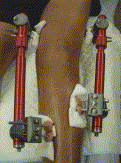Joint Distraction is similar to what I’m experimenting with via finger pulling.
“Knee joint distraction (KJD) provides clinical benefit and tissue structure modification at 1-year follow-up. The present study evaluates whether this benefit is preserved during the second year of follow-up.
Patients included in this study presented with end-stage knee OA and an indication for total knee replacement (TKR); they were less than 60 years old with a VAS pain ≥60 mm (n = 20). KJD was applied for 2 months (range 54-64 days) and clinical parameters assessed using the WOMAC questionnaire and VAS pain score. Changes in cartilage structure were measured using quantitative MRI, radiography, and biochemical analyses of collagen type II turnover (ELISA).
Average follow-up was 24 (range 23-25) months. Clinical improvement compared with baseline (BL) was observed at 2-year follow-up: WOMAC improved by 74% and VAS pain decreased by 61% Cartilage thickness observed by MRI (2.35 mm (2.06-2.65) at BL) was significantly greater at 2-year follow-up (2.78 mm (2.50-3.09); P = 0.03). Radiographic minimum joint space width (JSW) (1.1 mm (0.5-1.7) at BL) was significantly increased at 2-year follow-up as well (1.7 mm (1.1-2.3); P = 0.03). The denuded area of subchondral bone visualized by MRI (22% (95%CI, 12.5-31.5) at BL) was significantly decreased at 2-year follow-up (8% (3.6-12.2)). The ratio of collagen type II synthesis over breakdown was increased at 2-year follow-up.
Clinical improvement by KJD treatment is sustained for at least 2 years. Cartilage repair is still present after 2 years (MRI) and the newly formed tissue continues to be mechanically resilient as shown by an increased JSW under weight-bearing conditions.”
Below is the knee distraction method and a description:
“The distraction method was applied. In short, an external fixation frame consisting of two monotubes with internal coil springs was placed, bridging the knee joint. Each monotube was fixed to two bone pins on each end and, in stages, distracted for 5 mm (confirmed by X-ray). After instructions about pin site care, daily exercise, and physical therapy, the patients were discharged from the hospital. Patients were allowed and encouraged to load the distracted joint with full weight-bearing capacity, supported with crutches. In case of superficial (skin) pin tract infections, treatment with oral antibiotics for 5–7 days was provided (Flucloxacillin). Every 2 weeks the patients returned to the hospital and the monotubes were temporarily removed. The knee was bent, for 3–4 h, in a continuous passive motion device, with pain at the pin sites determining the maximum degree of flexion; on average, 25° (15–80°) flexion and full extension was reached. The monotubes were replaced and sufficient distraction was confirmed by X-ray examination and adjusted if needed.”
I think that this method of distraction is something that can be mimicked by something done manually.
“newly formed cartilaginous tissue; it might be, in part, fibrocartilaginous tissue.”
This study Effects of non-surgical joint distraction in the treatment of severe knee osteoarthritis. has the analysis of non-surgical but I can’t get the full study.
The idea of joint distraction in this case is not to stimulate the articular cartilage but to stimulate longitudinal bone growth. There is no practical evidence that this may be the case that I am aware. It is based on the observation that developing individuals have less pronounced epiphysis’ and that therefore the epiphysis may be a constraining factor on growth.
The epiphysis may constrain growth in a number of ways for example the two epiphysis may be akin to “like” charges of a battery and repel each other inhibiting further growth.
This study here does not provide any evidence about what affect joint distraction will have on healthy adults but it does show that joint distraction does have physiological effects on bone, cartilage, and likely MSCs. All ingredients for inducing longitudinal bone growth.


Hi Tyler,
I really don’t understand. I had previously sent an email stating that I increased my morning height by an entire centimeter and my evening height by half a centimeter in just 3 weeks. My height has even further increased since then. All I asked is that you send me an email so I can discuss the methods and help people on this site. I think we are doing the little things, like taking glucosamine, incorrectly. Please, respond. I have already gotten results.
Maybe you emailed wrong email address or that admin’s email is no longer used? I noticed Tyler replied you on previous Finger pull topic post.
All of his comments were directed at you. I have managed to gain an entire centimeter in the morning and half of that in the evening and still no reply. In the meantime, the admin posts an inversion table which he admittedly said only allowed for 1/4 inches of temporary increase. So i guess you could say I’m confused.
I don’t know if an inversion table is most effective as you’re only being pulled on one end and you have to tense up a little bit.
Imagine a slinky. You get a little bit of stretch if you dangle it. You get more stretch if you pull it both ends and you get the most if you manually set it at the maximal distance.
Also, I need to do more testing on finger pulling to make sure it’s not like articular cartilage thickness or anything and if the growth can be sustained. It’s only worth investigating further if the growth continues.
What a scary coincidence of all things. I was just about to message Tyler a few days about a device that I created for the knees that would grip the upper and lower leg and spread apart almost exactly like the photo. I thought it was a stupid idea and forged messaging him. I guess somebody else had the exact same idea.
Jaman, how old are you?
And could you please describe your routine?
I think it would interest all NHG readers.
Jaman, how old are you?
Could you please describe your routine?
I think it would interest NHG followers.